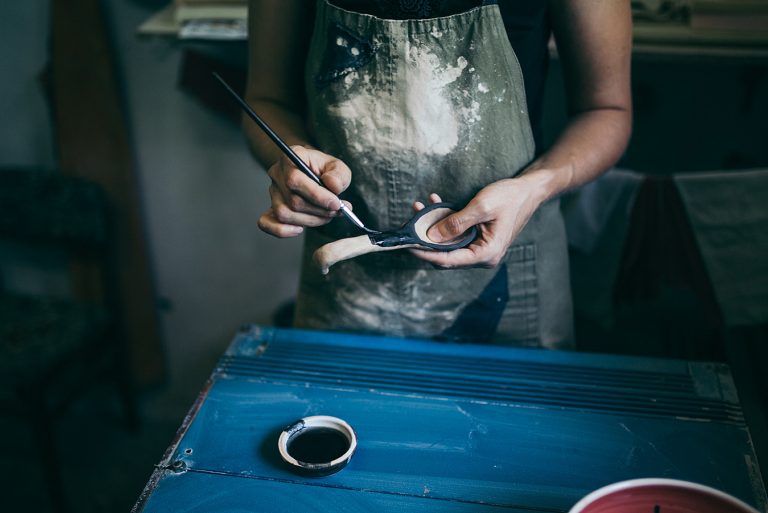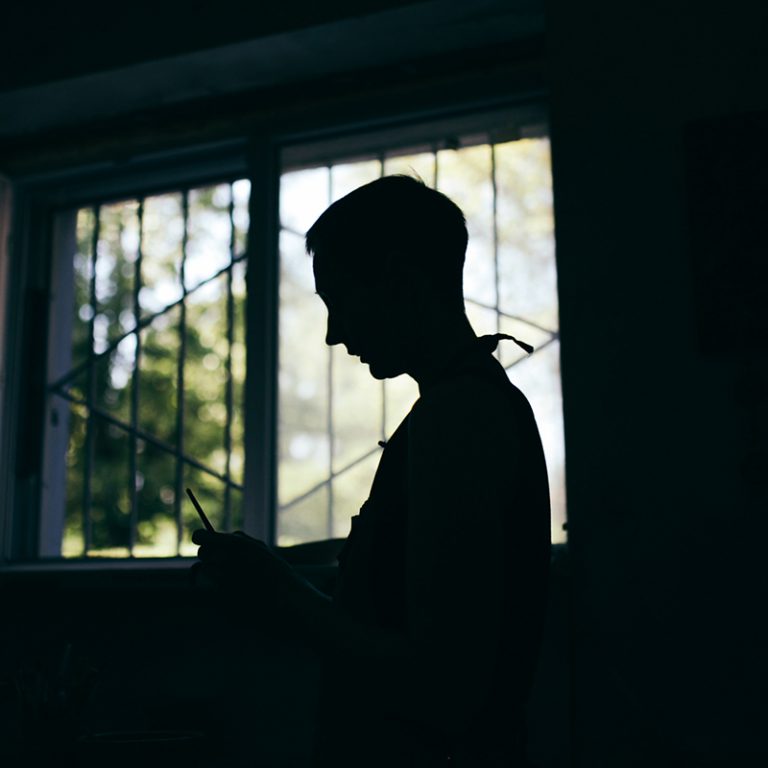With the beginning of the Russian occupation of Crimea in 2014, Tetiana Bolharova left the peninsula for the mainland of Ukraine, where she mastered pottery. In Kherson, she opened a workshop, where she now conducts masterclasses, teaching others to make pottery.
Tetiana Bolharova and her son left their native Crimea in 2014. Her parents stayed at home in Simferopol. First, Tetiana found accommodation in Volyn, where they lived for about a year. But due to the wet climate, they decided to move closer to home in the hope that the move would be temporary, and they would soon be able to go back to Crimea.
“My son had to attend the first year of school, and I simply didn’t want my child to grow up in a lie.”
They lived in Hola Prystan for another year. There Tatiana tried pottery in the historical and entertainment complex ‘Zeleni Khutory Tavrii’ (‘Green Hamlets of Tavria’ — tr.). The craft has become a kind of therapy for her:
“It was very hard when we were in Hola Prystan, going through this move. It was necessary to start from scratch, and emotionally and psychologically it was very hard. Clay saved me. From depression, from the feeling that you do not know what to do. Clay helped a lot: I found strength and found myself.”

Kherson. Pottery workshop
Later, Tetiana moved to Kherson, where she still lives and works. She got a job at an art school and at the same time developed a website, because she is a programmer by profession. She continued to work with clay and learn new techniques.
“At first it was good that it worked out [at all], but now I already see the shape, size, and I know I can do it. It’s so cool: I see the finished product, I see the result of what I dreamed of. When you work with a wheel, a certain peace comes to you. Your irritability subsides, as well as some nervous moments.”
The kiln had to be rented because before that the items had to be transported to the other end of the city. Many items cracked on the way. But these challenges only hardened the craftswoman.
“That’s how it went, I learnt it and then realised that I can’t do without it. There was no potter’s wheel, there was nothing of my own, but I could no longer carry on without pottery. It’s like a disease but in a good way. It seems to me that all potters, they are just in love. Because it’s hard, and you not only shape the clay, you also work as an installer and an electrician, because if something happens to the kiln, you have to take care of it. It’s easier to code: you have a laptop and you can work wherever you want. Go into nature and sit there to work. It’s not possible with pottery, but it’s such a love affair.”

Tetiana later won a grant from the International Organisation for Migration in the United Kingdom and bought a potter’s wheel. Now she rents a workshop, where she works and conducts masterclasses for those who want to learn pottery. She says that children come to sculpt often, because they are always ready to try something new. Instead, adults can hesitate for a long time, but once they dare, the process becomes very special:
“Adults already have this attitude that it should work, but it won’t. So I won’t sit down, I won’t do anything, it won’t work. Adults are more hesitant, they mull things over more. Nevertheless at some point they give it a try and realise that it’s not scary. Nobody judges you, nobody tells you if it worked or didn’t work out. That is to say, when a person creates something, one puts one’s heart into it. And opens up in the process. Adults are afraid for 10-15 minutes, and then they forget that they are in a masterclass, and produce a cool item.”
The potter especially appreciates the fact that the finished item can be touched. In contrast to programming, pottery offers a tangible result. And she is happy to watch the students full of joy when they manage to complete the work.
Tetiana teaches pottery to children with autism and dreams of making an exhibition of their works. The craftswoman knows from her own experience how clay heals and helps to find balance.
“Clay is very sensitive to our state of mind. That’s a fact. At first I saw it in other people, then I felt it myself. When there is no peace in the soul, when you are irritated, nothing comes out. First, calm down, leave all your problems behind and work. You start working, and you calm down even more. You forget about everything while you are in the process of work. It is very important. It’s reassuring. And it’s easier for a person. We are in a hurry, we have a very fast pace of life, and we do not have time to solve any emotional issues. And here you can look inside yourself during this time, you can stop.”

Clay therapy
Tetiana buys ready-made clay for her products. She likes to work with porcelain the most.
“It is very soft, very comfortable. It’s not exactly clay, to use the correct term it’s called a ceramic mass. It is very soft, and especially if you hold masterclasses for children, it is very nice for their hands. They always expect the clay to be harder, they touch it and are surprised that it is so soft, very pleasant.”
First, the clay for the future item is centered on the circle, i.e. the clay must be aligned in the centre of the circle and securely ‘stuck’ to it. Then one needs to form the base and the walls of the item. Before removing the item from the potter’s wheel, it must be dried so that it does not get damaged. Next, the dried product is fired, painted with glaze and sent back into the kiln. Ceramics should undergo two firings: the first is ten hours at a temperature above 1,000 degrees, and the second is at the same temperature for about nine hours. After the second firing, the item is ready for use.
The craftswoman likes to try new techniques in pottery. Now, for example, she decorates many of her kitchenware with carvings.
“You are constantly learning. It’s just that at some point you start to feel what you need to do. You merge with the clay, that’s all. You feel everything, and it starts going well. The main thing is not to be distracted, to focus on the process.”



slideshow
Tetiana also works in sgraffito and milk firing techniques. The highlight of Bolgarova’s workshop is the items with the Kherson watermelons pattern: mugs, cups, plates. According to the potter, they are in great demand in Ukraine and abroad.
“Kherson watermelons is a very simple technique. We make the item, burn it, then paint it with pigments, and apply transparent glaze on top. With colour there is always room for imagination. If you like drawing in masterclasses, you can create any of your fantasies here.”

Leaving in search of a home
In 2019, more than 40,000 migrants from Crimea were registered on the mainland of Ukraine. Most of them have similar needs, finding themselves far from home: to integrate into an unknown environment, to overcome financial and administrative difficulties, and finally to settle in a new place. Over the course of 4 years in Kherson, Tetiana has managed to improve her and her son’s life a little, but, according to her, it would have been much harder if she hadn’t come across good people on the way who were ready to help.
“People’s support is so warm. That is why Kherson is a warm city for us. We notice more good than bad here. Anything can happen, people are different. There are also those who are against us: ‘It is good in Crimea, why don’t you live in Crimea? What are you doing here? You are not immigrants at all.’ However, people are very different. There are more good people than bad.”
Tetiana’s son, Tymur, is 13 years old. He speaks excellent Ukrainian, helps his mother in the workshop, and is writing a book about the knights of the Middle Ages. He misses Crimea, and his childhood there, but he wants to live in Ukraine. In the future, following the example of his mother, he wants to become a programmer:
“I tell him: ‘Go for programming, and you’ll still have time for clay later.’ Especially since it’s easy for him, but it was difficult for me to code, and clay was very difficult for me. But it isn’t hard for children, they are constantly doing something with their hands. It’s normal for them. It is only later that we grow up and forget how to work with our hands.”
Tetiana is barely engaged in programming now, because she manages to earn money with the workshops. Her items can be purchased on her website and on foreign platforms, from where her cups, plates and pots spread all over the world. Above all, she appreciates the soulfulness of her craft and dreams that Ukrainians will begin to appreciate what’s theirs, what’s native, and more.
“There is a feeling that people are coming back, beginning to understand that handicraft is more valuable when the master puts a piece of his soul there. Even when I bring my items home, this feeling of warmth is there. This will never happen with factory kitchenware. And when we had our items, I brought them, and my son felt it. You take the dishes and they are warm. That’s why handmade work is important to me and should be present somewhere, there should be at least one bowl or cup. The house becomes warmer.”

For 6 years now, Tetiana Bolharova and her son have been dreaming of returning to Crimea. She says that people often think that they want to return purely for material reasons. However she admits that she misses not her own house or wealth left in Crimea, but the feeling of home, where you can breathe and think freely. She sees herself exclusively in Ukraine, and she would not be able to live anywhere else:
“I miss the feeling of home, and I understand that I will continue to miss it. I thought we had already decided to settle here in Kherson. But still there is this feeling of compulsion. Maybe it takes even more time, I don’t know, but we’ve been waiting for 6 years, and the feeling of home is not appearing. Home is there. Ukraine is everything for me. It’s freedom, it’s the opportunity to do what you want and everything. Well, just everything.”


